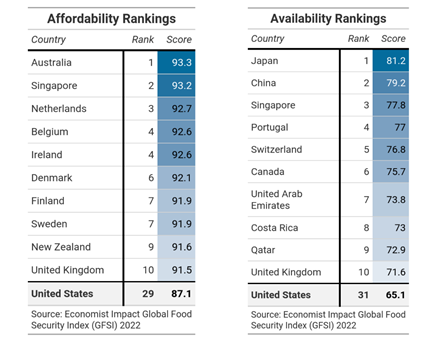
In 2021, about one of every 10 households was food insecure at some point, worrying that their food would run out before there was money to buy more. The costs of widespread food insecurity are felt everywhere, since hunger reduces productivity and costs the healthcare system billions of dollars each year.
As part of its focus on health, household financial well-being, and climate risk, the New York Fed’s Community Development team has held two events on the economic impacts of food insecurity, with a focus on scalable solutions. To help inform these discussions, the team analyzed Economist Impact’s Global Food Security Index (GSFI). Below are highlights from the events and analysis:
Challenges
- Structural challenges: While the United States performs well on the overall index—ranking 13th in the world—there are key pillars of food security where the United States scores below its peers in the Economist’s GSFI rankings, including affordability (29th) and availability (31st).

- Acute stressors: These structural challenges have been exacerbated by the COVID-19 pandemic, Russia’s invasion of Ukraine, and severe adverse climate events, which have all driven down affordability. Indeed, the U.S. went from first to 53rd in the world rankings for food inflation between 2018 and 2022, according to the GSFI. Speakers in our forums noted that this decline in affordability is hitting low- and moderate-income households especially hard.
Recommendations from Experts in the Field
- Coalition building: Participants in “Global Insights on Food Security and Economic Resilience” highlighted the need to connect stakeholders across the private sector, nonprofits, foundations, healthcare systems, and all levels of government (national, state, local). Most importantly, they argued that those who have experienced or are currently experiencing food insecurity must also be included in the discussions from the outset.
- Flexibility and innovation: Rob Vos, a director at the International Food Policy Research Institute, said that new technologies could help mitigate the adverse effects of food shortages and inflation, and that policymakers should expand investment in R&D to facilitate innovation. Panelists also stressed the importance of allowing space for and promoting flexibility in the design and administration of food and nutrition programs. As an example, they pointed to the SNAP waivers granted by the United States Department of Agriculture during the pandemic and the flexibility that they permitted.
- Sustained commitment: Tom Arnold, special envoy for food systems for Ireland, credited his country’s high rankings in the GFSI to the country’s two-decade-long effort to coordinate agricultural and government policies to improve national food security.
Relatedly, participants at the White House Conference on Hunger, Nutrition, and Health, held on September 28, echoed many of these recommendations: the need for partnerships, for innovation and flexibility, and for a consistent focus.
Potential Models
- Sustain & Serve NJ: Tara Colton, an executive at the New Jersey Economic Development Authority, highlighted the Sustain & Serve NJ program as an example of an initiative that combines each of the recommendations: coalition building, innovative use of funds, and sustained commitment. The program uses CARES Act dollars to provide nonprofits with grants to buy meals from New Jersey-based restaurants; those meals are then distributed for free to low- and moderate-income households. Since its launch in 2020, the $34 million program has distributed more than 3.5 million warm meals from more than 400 restaurants, with plans for significant expansion.
- Food security as healthcare: Vince Hall, chief government relations officer for Feeding America, said healthcare providers should consider a food security strategy as part of their patient care regimen. He noted that they could connect food insecure patients with nonprofits to assist them in obtaining resources, while partnering with state and local governments to ensure that at-risk patients receive the case management and government resources to which they are entitled.
Learn more about the Community Development team’s work on health.

Jacob Scott is a community development analyst at the New York Fed. He focuses on issues related to climate, health, and household financial well-being.
The views expressed in this article are those of the contributing authors and do not necessarily reflect the position of the New York Fed or the Federal Reserve System.










